February 2018
Hydrodemolition – A Concrete Removal Method For Our Times
Patrik Andersson
Aquajet Systems AB
www.aquajet.se
“With today’s emphasis on efficiency, cost-effectiveness and health and safety, hydrodemolition provides a concrete removal and refurbishment system for modern working conditions,” said Patrik Andersson, key account manager of Aquajet Systems AB of Sweden in a presentation at the 2014 WJTA-IMCA Expo in New Orleans.
The ear-splitting rattle of jackhammers is still a feature of construction, maintenance and demolition sites, but in recent years the use of hydrodemolition robots has proven to be so remarkably effective that many contractors and public sector organizations are investing in the machines.
Although the time of almost universal use for this sophisticated form of concrete removal is probably some way off, the advantages mean that it is fast gaining ground. Advances in automatic robotic technology mean that this equipment can now cope with almost 95% of all concrete repair tasks without any modifications.
One thing that is common among all types of concrete construction is the need for maintenance and refurbishment, and all are in need of repair 15 or 25 years into their lifecycle. At some point the owner of the structure is going to have to implement an extensive concrete refurbishment program.
The most common reasons for concrete damage are alkalide silica reaction, corrosion from salt or acid rain, physical damage from traffic, the weakening effects of the freeze-thaw cycle, chloride carbonation, and corrosion from steel reinforcement.
There are two main types of repair method: jackhammers and hydrodemolition.
Jackhammers represent a low initial investment, but they are labor intensive and have many disadvantages. A jackhammer can cause damage to the rebar and leave rusted and damaged rebar behind. It is all too easy to remove bad and good concrete alike and to leave an insufficient bonding surface. The vibrations can create additional cracks and cause stress to the structure and the operators alike. And it is noisy.
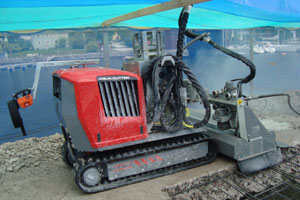
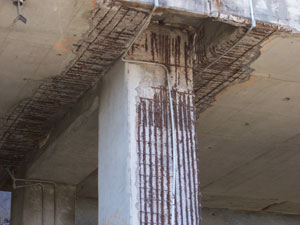
Hand/Arm Vibration Syndrome
Hydrodemolition avoids the medical problem that so often afflicts the operators of jackhammers. Known as Hand-Arm Vibration Syndrome, or HAVS, this is a condition that is caused by working with vibrating tools or machinery. It can lead to considerable pain and time off work and may result in permanent disability.
A related condition is Vibration White Finger, or VWF, used to describe damage to the circulation in the fingers. This leads to spells of numbness in the fingers, which can be both painful and dangerous for the operator.
Hydrodemolition, however, is very much a tool for today’s requirements. Among the benefits – selective removal system, no cracking, no dust pollution, a superior bonding surface, and no rebar damage. In fact, this method can be used to clean rebar of dust and concrete. Add to this the faster working speed, the substantial savings on labor, and the quiet operation of the hydrodemolition machine, and it can be seen why this method of concrete removal is steadily becoming more popular.
Health and environmental considerations are among the overriding factors of our time when it comes to construction and demolition.
.jpg)
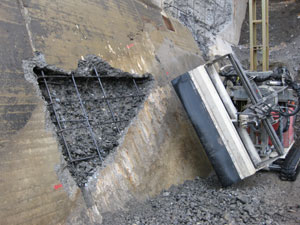
Hydrodemolition Benefits
Using hydrodemolition benefits both the operator and other site workers, and the people living and working in the vicinity of the site. The hazard of air-born silica dust and other particles is virtually eliminated as the particles are trapped in the runoff water, and injuries caused from the constant vibrations and heavy lifting of the jackhammers are avoided. For the surrounding area the noise of a hydrodemolition robot is minimal, as there is no percussion effect. There is no noise to spread throughout the structure, allowing work to be carried out in sensitive areas such as sites next to hotels, hospitals and residential developments. Not only does this benefit the neighborhood, it allows the contractor the potential of longer working hours in an area that might otherwise restrict the use of jackhammers.
A hydrodemolition robot uses high-pressure water, which is directed at the surface of the concrete where it penetrates the voids and micro-cracks. When the water pressure inside the voids overcomes the pressure of the concrete, a “blast” occurs. This means that a robotic unit can be used to accomplish removal in a controlled manner. Selective removal is one of the basic principles of hydrodemolition. It means you only remove the amount of concrete needed for the refurbishment, leaving the good concrete and the steel reinforcements undamaged.
Improved Bonding
Hydrodemolition also provides a better bonding surface. Jackhammers tend to leave a flat surface, but the waterjet provides a surface with peaks and valleys that provide grip. Independent tests have proven the bonding to be at least 50 percent higher than that of a surface prepared with jackhammers or sandblasting machines.
As hydrodemolition is impact-free there is no risk that the area treated will receive any impact or vibration damage. When rebar or other embedded steel is struck by a jackhammer, vibrations will travel deep into the concrete to areas of sound concrete. Micro-fractures and loosening of the rebar is often the result, and this can cause areas of potential future problems once the concrete is replaced.
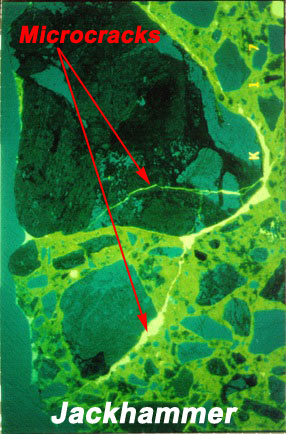
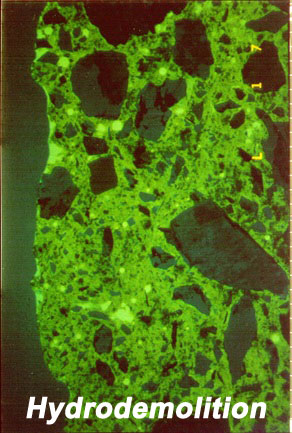
This article is excerpted from the February 2015 Jet News, a benefit of membership in WJTA-IMCA. For more information on membership, click here.